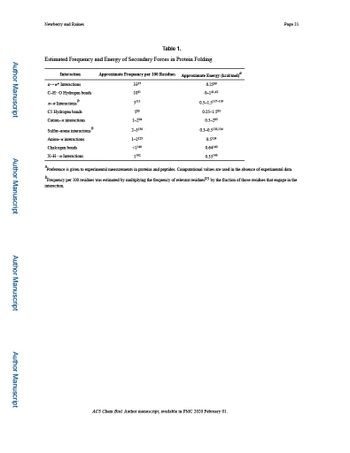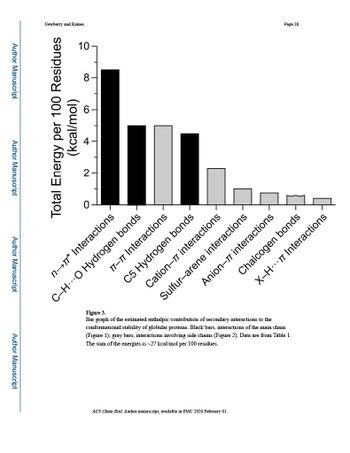Refer to the bar graph below, Explain why the n→π* interactions contributes more to the overall stabilization of the protein than all the other interactions(C-H-O hydrogen bond,π-π interactions, C5 Hydrogen Bonds, Cation-π interactions, Sulfur-arene interactions, Anion-π interactions, Chalcogen bonds, X-H-π interactions) even though n→π* is the weaker interaction. Explain why that's the case for EACH of the bonds. I.e Why n→π* interactions contribute more to the overall stabilization of the protein than C-H-O hydrogen bonds, even though n→π* is the weaker interaction. Why n→π* interactions contribute more to the overall stabilization of the protein than π-π interactions even though n→π* is the weaker interaction. Why n→π* interactions contribute more to the overall stabilization of the protein than C5 Hydrogen Bonds, even though n→π* is the weaker interaction.
Neutral Amino Acids
Amino acids which do not have any charge on them are neutral amino acids.
Globular Protein
The globular proteins refer to the shape of protein specifically spherical in nature apart from spherical form fibrous, disordered and membrane-bound proteins exist. These globular proteins are miscible in water and form a colloidal solution rather than other types which might not exhibit solubility. Many classes of the fold are found in globular proteins, which render them a sphere shape. Globular fold containing proteins usually are referred to by the term globin.
Dimer
Dimers are basic organic compounds, which are derivates of oligomers. It is formed by the combination of two monomers which could potentially be strong or weak and in most cases covalent or intermolecular in nature. Identical monomers are called homodimer, the non-identical dimers are called heterodimer. The method by which dimers are formed is known as “dimerization”.
Dipeptide
A dipeptide is considered a mixture of two distinct amino acids. Since the amino acids are distinct, based on their composition, two dipeptide's isomers can be produced. Various dipeptides are biologically essential and are therefore crucial to industry.
Refer to the bar graph below, Explain why the n→π* interactions contributes more to the overall stabilization of the protein than all the other interactions(C-H-O hydrogen bond,π-π interactions, C5 Hydrogen Bonds, Cation-π interactions, Sulfur-arene interactions, Anion-π interactions, Chalcogen bonds, X-H-π interactions) even though n→π* is the weaker interaction.
Explain why that's the case for EACH of the bonds.
I.e
Why n→π* interactions contribute more to the overall stabilization of the protein than C-H-O hydrogen bonds, even though n→π* is the weaker interaction.
Why n→π* interactions contribute more to the overall stabilization of the protein than π-π interactions even though n→π* is the weaker interaction.
Why n→π* interactions contribute more to the overall stabilization of the protein than C5 Hydrogen Bonds, even though n→π* is the weaker interaction.
Why n→π* interactions contribute more to the overall stabilization of the protein than Cation-π interactions, even though n→π* is the weaker interaction.
Why n→π* interactions contribute more to the overall stabilization of the protein than Sulfur-arene interactions, even though n→π* is the weaker interaction.
Why n→π* interactions contribute more to the overall stabilization of the protein than Anion-π interactions, even though n→π* is the weaker interaction.
Why n→π* interactions contribute more to the overall stabilization of the protein than Chalcogen bonds, even though n→π* is the weaker interaction.
Why n→π* interactions contribute more to the overall stabilization of the protein than X-H-π interactions, even though n→π* is the weaker interaction.

“Since you have posted a question with multiple sub-parts, we will solve the first three subparts for you. To get the remaining sub-part solved please repost the complete question and mention the sub-parts to be solved.”.
Proteins are complex molecules which are made up of long chains of amino acid residues.
The linear chain of amino acid residue is known as polypeptide and the individual amino acids are bonded together by peptide (-CONH-) bonds.
Step by step
Solved in 3 steps

Refer to the bar graph below, Explain why the n→π* interactions contributes more to the overall stabilization of the protein than all the other interactions(C-H-O hydrogen bond,π-π interactions, C5 Hydrogen Bonds, Cation-π interactions, Sulfur-arene interactions, Anion-π interactions, Chalcogen bonds, X-H-π interactions) even though n→π* is the weaker interaction.
Explain why that's the case for EACH of the bonds.
Why n→π* interactions contribute more to the overall stabilization of the protein than Sulfur-arene interactions, even though n→π* is the weaker interaction.
Why n→π* interactions contribute more to the overall stabilization of the protein than Anion-π interactions, even though n→π* is the weaker interaction.
Why n→π* interactions contribute more to the overall stabilization of the protein than Chalcogen bonds, even though n→π* is the weaker interaction.
Why n→π* interactions contribute more to the overall stabilization of the protein than X-H-π interactions, even though n→π* is the weaker interaction.










